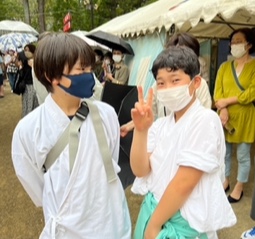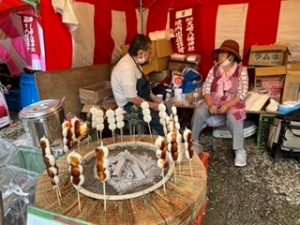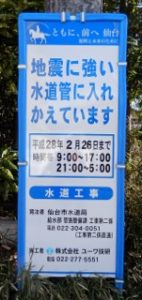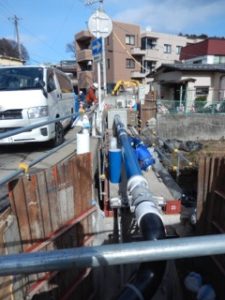Shinto Festival
- At October 05, 2022
- By anneblog
- In Uncategorized
 0
0
Dear Family and Friends,
A friend told me about a Shinto festival at Sendai’s Osaki-Hachiman-Jingu Shrine today. I had not been to one of their events in a long time, so decided to go. My friend’s son would be there helping. That, of course, added to my eagerness to attend.

As soon as my friend’s son could crawl and make his wishes known, he demanded that his mom take him to the Shrine so he could spend time with the priests. They loved him, of course, and let him crawl around, exploring as he wished. He has been going there ever since, and now at age eleven is happy to serve when and now he can.
I was not sure what to expect today. Osaki-Hachiman-Jingu has a variety of festivals throughout the year. For example, there a special day to honor and protect firemen. And another that entails competitions on horseback. Riders gallop at full speed along a short, narrow pathway, shooting arrows at targets set along the course. Onlookers are alarmingly nearby. And of course, there is Dontosai, held in the dead of winter. For that, male participants wear only loincloths (woman a bit more), and walk through the city ringing bells as they head to the Shrine. There New Year decorations are burned in huge bonfires.
So, what should I expect today?
Several blocks away from Osaki-Hachiman-Jingu, I could already hear the continuous whining drone of flutes and the slow, steady beat of drums. I wandered past festival food stalls

In the first one I watched, the dancers were not professional. Rather they were ordinary men connected to the Shrine.


I stayed for two dances and then slowly wandered around the grounds. Several small side Shrines have recently been constructed.


If I were younger, I probably would have stayed to the very end of the dances. But I knew I had to get home before becoming too tired. And I had an hour to walk home. The shrill drone of the flutes, and even throbbing of the drums followed me until I could no longer hear them. Of course, I knew the dances were continuing without me.
Although leaving before the end was something new for me, I rather liked it. I found it symbolic of my aging. And an important reality that I am working to come to terms with, and to accept with grace.
Leaving while the performances were continuing also allowed my day to come full cycle. It began it with Takemitsu Toru’s piece called “from me flows what you call time”. That is surely a prayer set to music and very much related to the eternal unfolding of life.
https://www.youtube.com/watch?v=kWipy3Q6gAI
Love,
Anne
The Bridge Under My Feet
- At September 11, 2016
- By anneblog
- In Annes Letters, Uncategorized
 0
0
9/11/2016
Dear Family and Friends,
9/11 burns and sears through the world psyche. Far from over, it rages relentlessly with no margins of forgiveness. And that is precisely why, now more than ever, it is essential to focus on what uplifts, what gives hope, what builds and rebuilds in the face of tragedy almost beyond the limits of our human capacity to grasp or to understand.
And sure enough, as you know well by now, rebuilding has been of prime importance these past five years in Tohoku. Reconstruction includes pretty much everything from the ground up. Roads, office buildings, and homes may be the most overt of these many changes. But there are others happening as well.
Right below where I live there is a small stream that winds its way between homes and gardens. The bridges over it are old and the water pipes under it are rickety. The narrow bridge nearest my apartment is one small structure, in one small neighborhood. Even so, the government realizes the importance of keeping it solid and strong. Hence repairs have been underway there for the past few months.
Signs let us know what is happening. “Please excuse the inconvenience as we install new, strong water pipes. We are doing this so that when the next earthquake comes you will be sure of having water.” Or “This bridge is being reinforced so you can go over it with confidence.” And “We care about your neighborhood, so are doing our best to make it safe for you.”

I either walk or ride my bike down that street daily, so the workmen know me, the lone foreigner in the area. I am often stopped so oncoming work vehicles can get by. And as I am waiting, one of the signalmen likes to chat. It turns out he speaks some English. “Hi. Where you from?” “I been to Niagara, Miami, Los Angeles, and San Francisco. America I like. My name is Asano Takashi, but please call me Hank.”

When I told him I wanted to write an article about the work he and his men were doing, he said, “Really? You crazy. This job very small, very, very small.” I asked him what would be better to write about. “Highways, big office buildings, the subway,” he said gesturing with wide-open arms.

“I know,” I replied, “but my theme is a bit different. I want to show the everyday life of people. I want my friends to know the many, many small things that are being done to rebuild this entire area of Tohoku. I think all these tiny repairs separately and together are very important.”
“I think you crazy,” he said with a beaming smile.
Maybe so, but precisely because of all the small, seemingly unimpressive repairs occurring everywhere, living here now can be very positive and uplifting. Of course, rebuilding is making life muddy and inconvenient; but it is also filling our psyches with hope. It gives a tremendous sense of security knowing the government cares enough to come to small neighborhoods to stabilize the very foundations upon which we live.

So indeed, the repairs happening on all levels, from the most impressive to the least significant, are all coming together to fortify our lives: our bodies, our minds, and our hearts. And that, in turn, allows us to look to each day positively and to the future with confidence that no matter what may come, we can and will endure.
Love,
Anne



